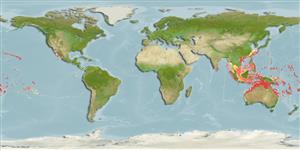Common names from other countries
Environment: milieu / climate zone / depth range / distribution range
Ecologia
marinhas associadas(os) a recifes; não migratória; intervalo de profundidade 0 - 120 m (Ref. 1602). Tropical; 30°N - 33°S
Pacific Ocean: Ryukyu Islands to the Philippines and extending to Lord Howe, Rapa and Tuamoto islands. Replaced by Chaetodon madagascariensis in the Indian Ocean, Chaetodon xanthurus in southeast Asia, and Chaetodon paucifasciatus in the Red Sea (Ref. 37816).
Tamanho / Peso / Idade
Maturity: Lm ? range ? - ? cm
Max length : 12.5 cm TL macho/indeterminado; (Ref. 4859)
Espinhos dorsais (total) : 12 - 14; Raios dorsais (total) : 21 - 23; Espinhos anais: 3; Raios anais : 16 - 17. Body color is white with 4-5 chevron-shaped blackish bands on the sides. The posterior portion of the trunk, the adjacent dorsal and anal fins, and the posterior portion of the caudal fin are yellow. A vertical black bar runs (uninterrupted) across the eye (Ref. 4855). Snout length 2.3-3.0 in HL. Body depth 1.7-1.8 in SL (Ref. 90102).
Inhabit deep lagoons and seaward reefs. Occur singly or in pairs. Feed on algae and small benthic invertebrates (Ref. 1602). Oviparous (Ref. 205). Form pairs during breeding (Ref. 205). May hybridize with C. xanthurus. Minimum depth reported taken from Ref. 128797.
Ciclo de vida ou comportamento de acasalamento
Maturities | Reprodução | Spawnings | Egg(s) | Fecundities | Larvas
Distinct pairing (Ref. 205).
Myers, R.F., 1991. Micronesian reef fishes. Second Ed. Coral Graphics, Barrigada, Guam. 298 p. (Ref. 1602)
Status na Lista Vermelha da UICN (Ref. 130435)
CITES (Ref. 128078)
Not Evaluated
Ameaça para os humanos
Harmless
Uso pelos humanos
Pescarias: pouco comercial; Aquário: Espécies comerciais
Ferramentas
Relatórios especiais
Baixar XML
Fontes da internet
Estimates based on models
Preferred temperature (Ref.
115969): 23.7 - 28.4, mean 26.8 (based on 202 cells).
Índice de diversidade filogenética (Ref.
82804): PD
50 = 0.5000 [Uniqueness, from 0.5 = low to 2.0 = high].
Bayesian length-weight: a=0.02239 (0.01427 - 0.03512), b=3.24 (3.11 - 3.37), in cm Total Length, based on LWR estimates for this species & Genus-body shape (Ref.
93245).
Nível Trófico (Ref.
69278): 3.0 ±0.41 se; based on food items.
Resiliência (Ref.
120179): Elevada, tempo mínimo de duplicação da população menor que 15 meses (Preliminary K or Fecundity.).
Fishing Vulnerability (Ref.
59153): Low vulnerability (10 of 100).
